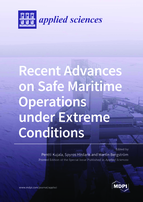Recent Advances on Safe Maritime Operations under Extreme Conditions
A special issue of Applied Sciences (ISSN 2076-3417). This special issue belongs to the section "Environmental Sciences".
Deadline for manuscript submissions: closed (10 April 2021) | Viewed by 17842
Special Issue Editors
2. School of Naval Architecture, Ocean and Civil Engineering, Shanghai Jiao Tong University, Shanghai, China
Interests: full-scale measurements of ice-induced loads and analysis of the ice load statistics; simulation of ship performance in ice; development of advanced structural solutions for ships; development of system-level safety of marine traffic
Special Issues, Collections and Topics in MDPI journals
Interests: wave loads; ship dynamics; ship safety in design and operations; emerging technologies; risk management; sustainability
Special Issues, Collections and Topics in MDPI journals
Interests: goal-/risk-based ship design; arctic shipping; ship safety; maritime sustainability
Special Issues, Collections and Topics in MDPI journals
Special Issue Information
Dear Colleagues,
The increased activity in the Arctic involves hazards such as a harsh environment, especially the ice cover and cold temperature, remoteness and lack of infrastructure, and lack of information about bathymetry, among others. Ice cover is also highly variable and dynamic, with increasing variation in the future as, due to the changing effects of the world climate, the ice conditions on all ice-covered areas are also under dynamic change. This effect on Arctic operations is a complicated task to solve. The remoteness of the Arctic areas means that in case of an accident, the search and rescue (SAR) capability is low. Further, the fairways are not marked very extensively, and especially the soundings taken for charting are relatively scarce. These Polar area hazards are compounded by the fact that the rate of recovery of nature is slow, meaning that environmental hazards are made more serious.
The focus of this Special Issue will be research related to the recommended practice on scenario-based risk management for Polar shipping and risk-based guidelines considering holistically the impact of risks on ice infested waters. These can include: (a) Definition of ice conditions, (b) ship–ice contact, (c) numerical models/idealizations, (d) definition of limit states for ice-strengthened structures, and (e) holistic risk–reward analysis for Polar navigation. Articles submitted to this Special Issue can also deal with the most significant recent developments in the abovementioned areas. We invite researchers to contribute original research articles as well as review articles that will stimulate the continuing research effort on the future needs to guarantee safe shipping in ice waters.
Prof. Dr. Pentti Kujala
Prof. Dr. Spyros Hirdaris
Dr. Martin Bergström
Guest Editors
Manuscript Submission Information
Manuscripts should be submitted online at www.mdpi.com by registering and logging in to this website. Once you are registered, click here to go to the submission form. Manuscripts can be submitted until the deadline. All submissions that pass pre-check are peer-reviewed. Accepted papers will be published continuously in the journal (as soon as accepted) and will be listed together on the special issue website. Research articles, review articles as well as short communications are invited. For planned papers, a title and short abstract (about 100 words) can be sent to the Editorial Office for announcement on this website.
Submitted manuscripts should not have been published previously, nor be under consideration for publication elsewhere (except conference proceedings papers). All manuscripts are thoroughly refereed through a single-blind peer-review process. A guide for authors and other relevant information for submission of manuscripts is available on the Instructions for Authors page. Applied Sciences is an international peer-reviewed open access semimonthly journal published by MDPI.
Please visit the Instructions for Authors page before submitting a manuscript. The Article Processing Charge (APC) for publication in this open access journal is 2400 CHF (Swiss Francs). Submitted papers should be well formatted and use good English. Authors may use MDPI's English editing service prior to publication or during author revisions.
Keywords
- Polar navigation
- Risk-based design
- Ice conditions
- Ship–ice and ship–ice–water interactions
- Ice failure
- Numerical models and model tests
- Limit states of structures
- Risk–reward analysis
- Operations management
- Accident statistics








